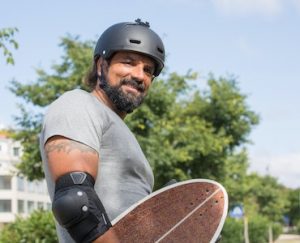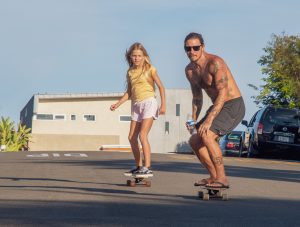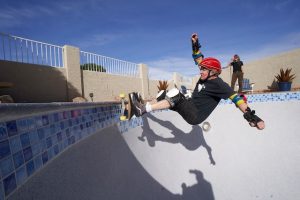We’ve all seen those individuals effortlessly carving up the pavement through skateboarding. Skateboarding is a fun and creative way to get around and an excellent tool to obtain body sculpting and toning. In this article, FamilyHype dives into the world of ‘body sculpting on wheels’ and discovers how the sport of skateboarding can help us achieve fitness and muscle goals.
We’ll explore its benefits, understand how it works to benefit our body toning, discuss safety measures, and reveal ways to incorporate it into our fitness routine.

So stay tuned whether you’re already a seasoned skater or just interested in trying something new for your physical well-being! It’s time to start skating and discover how it can increase your cardio fitness and do leg exercise with your skate, making it one of the best ways to achieve a strong, toned physique.
From board brands, styles, and sizes to skate parks, local events, and the latest tricks, this article will provide an overview of the skateboard world and its potential for muscle toning. We’ll also share tips and tricks to help you get the most out of the sport and achieve your body sculpting goals.
Please share your thoughts and experiences with us in the comments section, and let’s explore the exciting possibilities of body sculpting on wheels!
Key Takeaways
Skateboarding is a fun and creative way to get around and a fantastic tool to obtain body sculpting and muscle toning. It offers numerous benefits for overall fitness, including cardiovascular benefits, improved core strength, and enhanced balance and coordination.
Safety measures are essential when skateboarding, and proper protective gear, including helmets, knee and elbow pads, wrist guards, and protective clothing, should always be used to prevent injuries.
Incorporating skateboarding into your fitness routine can make workouts more enjoyable and effective. It is an accessible and enjoyable way to stay active, improve balance, and achieve fitness goals.
Interviews with pro skateboarders demonstrate how skateboarding can be an effective tool to obtain body sculpting and building strength. The stories of success from professionals worldwide inspire and motivate others to consider skateboarding as an important part of their strength training and body toning journey. Skateboarding consistently builds muscles, helps lose weight, and provides good workout opportunities, making it a form of exercise with numerous health benefits.
Longboarding isn’t just a sport; it’s a lifestyle that promotes health and muscle strength. It offers a unique and creative way to work with various body tissue groups and stay active, making it an exciting journey toward achieving a more robust and healthier body. So grab your board and start shredding for a healthier, more active lifestyle!
The Basics Of Skateboard Riding
Skateboarding is an exciting sport involving skateboarding a small board with wheels. Mastering the basics is essential before delving into more advanced tricks and maneuvers. Here are the key elements to get started:
- Skateboard Components: Understanding the different parts of a board is crucial. The main components include the deck (the wooden board), trucks (metal axles that hold the wheels), wheels, and bearings (to allow the wheels to roll smoothly).
- Balance and Stance: Learning to maintain balance while standing on the board is fundamental. The stance is how the skater positions their feet on the board—either regular (left foot forward) or goofy (right foot forward).
- Pushing: To move forward, skateboarders use their feet to push against the ground. Pushing techniques and foot placement are vital in maintaining speed and control.
- Turning: Steering the board is done by shifting body weight and applying pressure to the toes or heels. Mastering the art of turning is crucial for navigating around obstacles and making smooth transitions.
- Braking: Stopping the board can be achieved by using the back foot as a brake or by using specialized slide techniques.
- Getting on and off the Board: Learning to step onto the board smoothly and dismount safely is essential to avoid accidents.
- Falling Safely: Falling is a part of learning any action sport. Skateboarders should practice falling safely to minimize the risk of injuries.

Once these basics are mastered, skateboarders can progress to more advanced skills and tricks, such as ollies, kickflips, and grind maneuvers. Regularly wearing appropriate safety gear, including helmets, knee and elbow pads, and wrist guards, is important to ensure a safe and enjoyable experience.
Body And Health Improvement Through Skateboarding
Let’s dive into how effective it is to do skateboarding for muscle improvement. It offers immense cardiovascular benefits, keeps our hearts healthy and our stamina high, and aids in building core strength.
So we’re not just having fun but carving out a more substantial, healthier body with every ride!
The Heart Improvement
It provides significant cardiovascular benefits that contribute to overall fitness and heart health. When skateboarding, the constant movement and effort engage various body systems and elevate the heart rate, promoting improved blood circulation and cardiovascular endurance.
As professionals propel themselves forward with their feet, they engage the lower body muscles, such as the quadriceps, hamstrings, and calves. This repetitive motion is an effective cardiovascular workout, similar to aerobic exercises for building muscles like running or cycling. The increased heart rate during your rides helps strengthen the heart, enhance lung capacity, and improve stamina. Skateboarding build great body.
Moreover, this requires balance and coordination, further activating the core muscles and stabilizers. These muscles work together to maintain balance on the board, enhancing core strength and stability. Cardiovascular exercise and core engagement make skateboarding build excellent full-body workout.
Strengthening Your Core
Skateboarding is an exceptional way to strengthen the core muscles and improve overall balance. The core muscles, which include the abdominals, obliques, and lower back muscles, play a crucial role in maintaining stability and supporting the body during dynamic movements and as skateboarding build your body, you’re going to feel great. In the absence of these kinds of exercises, you lose muscle over time.
When skateboarding, the body constantly adjusts to maintain balance on the moving platform. This continuous engagement of the core muscles helps to improve strength and endurance in these body tissue groups. As skateboarders turn, twist, and perform tricks, they further challenge their core, leading to increased body tone and stability.

Having a strong core not only improves performance but also benefits overall physical health. A strong core contributes to better posture, reduced risk of back pain, and enhanced functional movements in daily activities.
Through consistent practice, individuals can progressively build their core strength and improve their overall balance and coordination, leading to a more sculpted and stable body. It’s a fun and rewarding way to improve core muscle groups while enjoying the thrill of skateboarding. Read on to understand how skateboarding build muscle strength with consistent practice.
How Skateboarding Can Improve Vigor
Skateboarding engages various body tissue groups throughout the body, making it an effective full-body workout. As skateboarders maneuver on their boards, they activate and strengthen muscle groups in their legs, core, arms, and even the upper body through bodyweight exercises.
- Legs: The lower body plays a significant role in this sport. The quadriceps, hamstrings, and calf muscle groups are activated when pushing off the ground to gain speed. These muscle groups propel the board forward and maintain balance while skateboarding.
- Core: Skateboarding demands constant balance and stability, which engages the core muscle groups, including the abdominals, obliques, and lower back. The core muscles are responsible for maintaining an upright posture on the skateboard and supporting various tricks and maneuvers.
- Arms and Upper Body: It also involves the upper body in maintaining balance and control. As skateboarders shift their weight and perform tricks, they utilize their arms and shoulders to steer and maintain stability.
- Back: The muscle groups in the back are engaged to keep the body upright and aligned on the board. A strong back is crucial for maintaining proper posture and preventing injuries during skateboard skateboarding.
- Glutes: The gluteal muscle groups, particularly the gluteus maximus, are activated during movements like squatting, jumping, and landing while skateboarding your board.
- Hip Flexors: The hip flexors, a group of muscle groups that connect the hips and thighs, are engaged during skateboard skateboarding, especially when performing tricks that involve lifting the legs.
- Ankles and Feet: The continuous movements of the feet and ankles are essential for maintaining control and balance on the board. Skateboarding your board helps strengthen the muscle groups and ligaments in the feet and ankles.
Not only is skateboarding good exercise, but by working for these various body tissue groups, skateboarding provides an all-encompassing workout that enhances strength, coordination, and overall fitness by losing more calories. Regular practice can improve body tone and increase body sculpting over time. Moreover, cardiovascular exercise and muscle engagement make this an effective and enjoyable fitness activity for people of all ages.
Some Safety Measures To Remember
Safety is paramount to prevent injuries and ensure a positive and enjoyable experience. Whether you’re a beginner or an experienced skateboarder, following these safety measures is essential:
- Wear Protective Gear: Always wear appropriate safety equipment, including helmets, knee pads, elbow pads, and wrist guards. These protectors can prevent serious injuries in case of falls or accidents.
- Proper Footwear: Wear sturdy and supportive closed-toe shoes while skateboarding. Avoid sandals or flip-flops that can lead to foot injuries.
- Choose the Right Skateboard: Select a skateboard that suits your skill level and intended use. Consult with experts or experienced skateboarders if you’re unsure about the right size and type of skateboard.
- Warm-up: Before hitting the skate park or street, warm up your body with light stretching and exercises to prepare your muscle groups and joints.
- Know Your Limits: Skate within your skill level and course and avoid attempting tricks or maneuvers beyond your abilities. Progress in a slow but accurate manner by gradually focusing on building your skills safely.
- Skate in Designated Areas: Use skate parks or designated areas whenever possible and avoid unstable surfaces. These areas are specifically designed for skateboarding and have smoother surfaces and ramps for safer skateboarding.
- Be Aware of Surroundings: Stay vigilant of your surroundings, including pedestrians, cyclists, and other skaters. Avoid crowded areas and be respectful of others’ space.
- Practice Falling: Learn how to fall safely to reduce the risk of injury. Do a better job of trying to roll with the fall rather than brace yourself with your hands, which can lead to wrist injuries.
- Avoid Skateboarding in Wet or Hazardous Conditions: Wet surfaces can be slippery and dangerous. Avoid skateboarding in wet weather or on surfaces with loose debris that can cause accidents.
- Stay Hydrated: It can be physically demanding on your strength and power, so remember to stay hydrated during your sessions.
- Skate with Others: Skateboarding with friends or in groups can be a bit safer as you can look out for each other and offer help in emergencies.
- Respect Traffic Rules: If skateboarding on streets or roads, obey traffic laws and signals to ensure your safety and the safety of others.

By following these safety measures, you can enjoy skateboarding while minimizing the risk of injuries and accidents. Always prioritize safety and be mindful of your actions while skateboarding. Remember, wearing safety equipment and knowing your limits can significantly prevent unnecessary injuries and make this a fun and rewarding activity. Additionally, consider undergoing training for skateboarding to improve your skills and learn essential techniques. Proper training for skateboarding can provide you with the knowledge and confidence to navigate various challenges safely, ensuring that you make the most of this exciting sport.
Incorporating It Into Your Fitness Routine
Skateboarding offers an exciting and enjoyable way to incorporate fitness into your routine. It provides immense cardiovascular benefits, builds core strength, and engages various body systems, making it a full-body workout. It challenges balance, coordination, and flexibility while promoting mental well-being and reducing stress.
By incorporating training for skateboarding into your fitness regimen, you can have fun while achieving your fitness goals, all while staying safe and wearing proper protective gear. Engaging in daily skateboarding sessions boosts your energy levels and enhances your overall movement skills. So, grab your board, engage in training for skateboarding, and enjoy the journey to a healthier and more active lifestyle. Stay tuned for more content on skateboarding and related fitness tips to keep you motivated and informed.
Conclusion
Skateboarding is more than a fun way to get around; it’s a powerful tool to obtain body sculpting and body toning. Throughout this article, we’ve explored the various benefits of this sport for fitness, understanding how it works for different muscularities, and the importance of safety measures.
Moreover, it offers immense cardiovascular benefits, keeping our hearts healthy and stamina high while building core strength and improving balance. It engages many body parts, including the legs, core, arms, and upper body, making it a comprehensive full-body workout. By consistently practicing, individuals can sculpt their bodies and improve their physical fitness.
Safety is paramount in any sport, and protective gear is crucial to prevent injuries. Helmets, knee pads, elbow pads, and wrist guards should always be worn to ensure a safe and enjoyable experience.
Incorporating this sport is a great option to enhance their fitness routine. It adds fun and adrenaline to workouts, making fitness enjoyable and engaging. Whether you’re a seasoned one or a beginner, this sport offers an accessible and enjoyable way to stay active and achieve fitness goals.
Incorporating it into your fitness routine can be a transformative physical and mental journey. It offers a unique and creative way to achieve a stronger and healthier body while enjoying the thrill of skateboarding.
So, whether you’re new to skateboarding or a seasoned pro, it’s time to grab your board, practice safely, and roll towards a healthier, more active lifestyle. Embrace this sport as a means to achieve a strong, toned physique and experience the exhilaration of body sculpting on wheels! Don’t forget to share your thoughts and experiences with us in the comments section as we explore the exciting possibilities of of this sport for fitness.
Happy shredding!
Frequently Asked Questions (FAQs):
Which Core Muscles Are Crucial For Maintaining The Balance In Skateboarding?
Maintaining balance in skateboarding requires engagement from various core muscle group, including the abdominals, obliques, and lower back muscle group. These muscles work together to stabilize the torso and support dynamic movements on the board.
How Do The Skateboarding Activities Develop Different Strength Groups?
What Muscles Do Skaters Use?
They use a variety of muscles during their activities. The main muscle groups engaged include the quadriceps, hamstrings, and calf muscles in the legs, the core muscles (abdominals, obliques, and lower back) for balance and stability, and the arms and upper body for steering and control.
Does Skating Build Abs And Stamina?
Yes, skating can help build abdominal muscles. The balance and stability required when skateboarding engage the core muscles, contributing to improved core strength and muscular endurance. This dynamic engagement is beneficial for both building muscle mass and enhancing overall skateboarding performance. While skating offers significant physical benefits, incorporating targeted ab exercises can further enhance muscle building and specifically target the development of abdominal muscles.
Does Skating Make Your Glutes Bigger?
Skating can help strengthen and tone the glutes (buttocks) as they are engaged while pushing off the ground and maintaining balance on the skateboard. While skating can contribute to muscle improvement, getting significantly bigger glutes may require additional strength training exercises.
Should You Work Out Before Or After Skateboarding?
The best approach may vary depending on personal preferences and fitness goals. Some prefer to warm up with light stretching and exercises before skateboarding to prepare their muscles and joints. Others may choose to do their skateboarding session first and then follow it up with a post workout to focus on specific muscle groups.
Do Board Riders Lift Weights?
Some skateboarders incorporate weightlifting into their training routine to enhance their performance and build overall strength. Weightlifting can target specific muscle groups not heavily engaged during skateboarding and complement the sport’s physical demands. So, start with the right amount of easy to high intensity workout in your home.
Should You Take Rest Days From Skateboarding?
Yes, rest days are essential for muscle recovery and injury prevention. This physically demanding sport requires a unique combination of skills, including balance training and the engagement of various core muscles. Incorporating rest days not only allows to consider muscle repair but also contributes to improved cardiovascular health. Beyond the physical aspects, rest days provide mental benefits, supporting overall mental health. Skateboarding demands more effort than meets the eye, and taking breaks helps enhance motor skills while promoting a healthy balance between exertion and recovery.
How Many Days A Week Should I Skateboard?
The frequency of sessions depends on people fitness levels, goals, and recovery abilities. Beginners, starting with a few days a week and gradually increasing the frequency is recommended. We always recommend to people to push their limits. Intermediate to advanced riders may choose to do it several days a week, allowing for rest days in between to avoid overtraining.
How Many Hours Does It Take To Get Good At Skateboarding?
The time it takes to become proficient at skateboarding varies widely based on individual dedication, natural ability, and practice frequency. Some individuals may progress more quickly with regular and focused practice, while others may take more time to improve their skills. Skateboarding require consistent practice and determination, and the hours invested in honing one’s abilities contribute significantly to improvement in this dynamic sport.
Last Updated on June 30, 2024 by Harold Chan
DISCLAIMER (IMPORTANT): This information (including all text, images, audio, or other formats on FamilyHype.com) is not intended to be a substitute for informed professional advice, diagnosis, endorsement or treatment. You should not take any action or avoid taking action without consulting a qualified professional. Always seek the advice of your physician or other qualified health provider with any questions about medical conditions. Do not disregard professional medical advice or delay seeking advice or treatment because of something you have read here a FamilyHype.com.